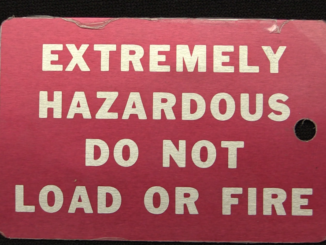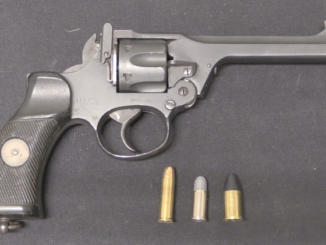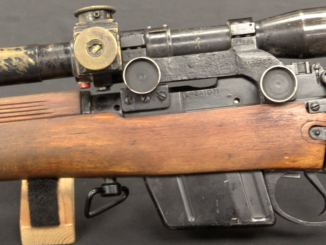Pretty much every major military had an antitank rifle in service when WW2 kicked off, and the British example was the Boys AT rifle, named after the Captain Boys who designed it. It was a bolt action .55 caliber rifle with 5-round detachable magazines. If was obsolete by 1943 and replaced by the more effective but equally unpleasant PIAT.
Related Articles

Semiauto Rifles
S&W 1940 Light Rifles: Receiver Breakage is a Problem
Mark I Mark II Designed in 1939 by S&W engineer Edward Pomeroy, the S&W Light Rifle is an extremely well manufactured but rather poorly thought out carbine. It is a 9mm Parabellum open-bolt, semiautomatic, blowback […]

Revolver
Scotland’s Only WW2 Military Firearm: Albion Motors No2 MkI** Revolver
One of the lessons the British military took from the Great War was that without extensive training and practice, most people were not very effective with a large-bore revolver. So in 1922, they undertook a […]

Bolt Action Rifles
The Last Lee Enfield: the L42A1 Sniper
RIA’s catalog page for this rifle When the British military adopted the FAL (L1A1 SLR) in 1960, they adopted the 7.62x51mm NATO cartridge along with it. While the Brens guns were converted to the new […]

Thanks for another informative presentation Ian.
As a kid-young man in the 1950s-early 60s I recall these being offered for sale in various firearm magazines of the day.
I remember that they were not very expensive, albeit, too expensive for this young-one growing up in rural Central Valley California. However, I did buy a WWII model British Enfield for $10 but my mom would not allow me to buy a Webley revolver for $15 from Mr. Whitehouses’ Gun Shop on G street. Those were the days!
Thanks again Ian.
Pat
“$10(…)$15(…)Those were the days!”
Then the $1 = 13.71 grains gold (or 1 troy ounce = $35)
Years ago I found a metal transport box for the magazines in a thrift store for ten bucks; sold it to a collector in England for a substantially greater amount.
The previous owner had smashed flat the separating ribs in order to use it as a tool box, the schmuck!!
Very cool video as always, Ian; thank you!
And I thought I had problems with gremlins.
Do they have PTRD/PTRS to compare? PTRD with it’s back-recoiling 1/4 automatic barrel action is quite interesting…
PTRD & PTRS manual(in Russian + drawings):
http://www.rkka.ru/docs/real/ptrd/index.htm
Thanks for the link! Not sure why it wasn’t working, but I fixed. it.
There is also bigger manual for PTRD & PTRS here:
http://broneboy.ru/противотанковое-оружие/противотанковое-оружие-пехоты/птрс/
(click in скачать / открыть в djvu near Наставление по стрелковому делу (НСД-42) ПТРД, ПТРС. НКО СССР, 1942 г. to download djvu file, you need proper program to open djvu file)
Looking at Simonovs’s rifle performance – it is phenomenal; 50mm penetration at 100m; 40mm pen. at 200m range. The documentation and presentation are pretty good too.
“penetration”
To be exact penetration is cartridge performance not rifle or gun; Russian 14.5x114mm is substantially bigger than American .50 Browning or other similar cartridges. B-32 bullet has V25 (velocity 25m from muzle) = 980-995m/s, so I assume over 1000m/s at muzzle, bullet mass is 62,6 – 64,6 g. This bullet is AP-I and has 80% chance to set on fire gasoline tank hidden behind 20mm armour at distance of 100m.
Newer BS-41 bullet has tungsten carbide core (unlike B-32 which has steel core) to enhance penetration, this bullet is AP-I too.
SA -marking means that this rifle has been in Finland.
British donated us 200 rifles during the Winter War.
100 were delivered and used in battle jan-march 1940 of which 30 rifles were used by the Swedish Voluntary Core in Lappland. Those another 100 came too late to see any combataction in Winter War. Another batch of 200 rifles were bought from the germans in 1940. All were used in Continuation War but were phased out of frontline in 1943. After the war they were maintained (crappy ones destroyed) and storaged until august 1956, when all remaining 330 rifles were sold to CIA (Samuel Cummings).
I have shot one of these that were converted to .50BMG. It was an early one like this one and it made a crater in the ground from repeated firing. It wasn’t bad to shoot though. It didn’t even make a bruise on my shoulder. Maybe the “incapacitating” reputation comes from those shooting without hearing protection?
The felt recoil of the Boys is substantially less than most people would expect due to its “upper carriage”, not unlike that of some artillery pieces. That said, no 12.7-13mm class AMR is a lightweight in the recoil department.
One big advantage the Boys had over the PIAT was that at least if you didn’t hold it quite tightly enough when firing, you only got a bruised shoulder. Do the same with a PIAT, and you got knocked flat on your a$$, plus the firing spigot didn’t recoil far enough or hard enough to recock itself.
Which meant you had to do the “stand on the shoulder rest, half-turn the body, and haul up on it like a chest exerciser” maneuver to recock it. If you didn’t get your stance just right, the powerful spring would yank you back down into a hairpin, hard enough to cause a spinal disc dislocation.
As Ian Hogg observed, “Anyone less than five feet seven inches tall was laying himself open to an injury trying to cock a PIAT. An even more entertaining pastime was trying to cock it while lying in a slit trench”.
The PIAT was a highly effective AT weapon, and a nasty indirect-fire one, too. But at least the Boys didn’t provide extra trade for chiropractors.
cheers
eon
I recall reading an article on PIAT by someone who’d served with one. They said there was a joke that the ideal user was 20/20, weighing 20stone with an IQ of 20.
Well, I suppose the PIAT should have been mounted on something else. Try putting it in an armored vehicle instead?
It was descended from a ground-mounted, crew-served AT spigot mortar. See “Blacker Bombard”;
https://en.wikipedia.org/wiki/Blacker_Bombard
The recoil-cocked spring spigot part was intended to increase the rate of fire.
One useful peculiarity of the PIAT was that by elevating the monopod to maximum, and rotating the shoulder rest a quarter-turn to act as a ‘spade’, it could be used as an impromptu mortar, flinging its large and powerful HEAT bomb up to 300 yards in indirect fire. In the bocage country, British and Commonwealth troops used this trick to drop the bomb onto the roof of German panzers across a couple of fields without showing themselves.
“Top attack” with HEAT didn’t originate with the Bofors Bill. The PIAT was playing that game in 1944-45.
cheers
eon
The RPG-43 predates the PIAT and it could be used for “top attack”, although it required considerable skill:
https://en.wikipedia.org/wiki/RPG-43
Ah, an Rpg 43 the “fat” stick grenade,
http://www.gettyimages.co.uk/detail/news-photo/russia-volgograd-volgograd-memorial-for-the-victims-at-the-news-photo/548212477
the statue holds, that’s probably a representation of one I always thought it was a somewhat out of prospective RGD-33.
Well, take a look what you think: https://www.youtube.com/watch?v=vZNXtUFMMd8
The recoil is substantial.
I purchased one of these Boys in 1960 for $79.00 that came with a wooden box and two metal boxes of magazines, along with 100 rounds of ammunition. I also purchased a 20 mm Lathi in its case with a lot of magazines and a large spare part kit with 200 rounds of ammunition for $114.00! I worked as a warehouse stocker for InterArms in Alexandria Va before being picked up for training by a company that did a lot of business with Sam Cummings. I was in RVN in 1968 when the gun control act came into effect and had the Boys converted to Cal 50 US., besides the barrel change the magazine well and magazines had to be extended for the longer 50 cal round. It was a much better (read accurate) gun in US 50 cal. I never felt that the recoil was that bad but I always bolted the Monopod down to something solid like a vehicle. I sold the 20 mm and all of its accessories to someone in Wyoming for much more than I paid for it. I kept the Boys until the early 80’s when I went back to Germany as an Advisor for the US Army, it was also a Finnish Army marked gun. Harry
Very cool! I can only imagine being able to see what was coming into InterArms… 🙂
Harry, write a memoir. InterArms, and anything related to those wild days of cheap imports and cowboy arms merchants would sell like hotcakes.
Every “expert” opinion given on the Boys from WW2 to the 80s condemmed it as useless and obsolete when it was introduced. Then about 1990 every army adopted a similar arm in 50BMG as an anti material weapon. Actually it can be considered as a concept ahead of its time.
Exactly. Don’t shoot tanks with the Boys. Shoot the idiots hiding behind the brick walls…
I don’t think any army adopted the modern “anti-materiel” use for anti-tank rifles during WW2, although the front-line soldiers used them that way in may occasions. The Boys was considered obsolete and useless largely since it was very marginal against any toher Axis armor expect PzKw I, Italian L3 tankette and light armored cars. Partially that was because the British did not develop a tungsten-carbide core bullet in time. One was finally developed in 1942, but it was not issued, since the PIAT was already in development, and tungsten was an expensive strategic material. If it had been available in 1940, the reputation of the Boys would probably be better.
The Boys, like all anti-tank rifles to a degree, also suffered from the inevitable fact that a penetration of the armor did not always disable to destroy the armored vehicle. On many occasions the bullet would inflict minimal damage to the occupants or vulnerable parts of the vehicle, in other words, behind armor effects were small. As a general rule, the larger the caliber of the bullet, the better the behind-armor effects. The Swiss Solothurn S-18/1000 and the Finnish Lahti, which fired the 20x138mmB “Long Solothurn” cartridge had less problems with ineffective penetrations (the same cartridge was fired also by the KwK 30/38 of the PzKw II).
Fairly Sure the US Marines used these up through the Island campaigns of WWII. Still useful against Japanese “Tanks” and pillboxes.
Actually, some Japanese fortifications were practically battleship proof. All the coconut shells, coral, and sand between layers of concrete absorbed impacts from incoming artillery and anti-material rifles… And then there were the Japanese Anti-tank guns hidden in the cliff sides, which opened only when nobody was looking and then the Japanese would let your commander have a 75mm AT round right between the eyes.
47mm, more likely, considering the Japanese did not have dedicated 75mm AT guns. They did use the Type 90 field gun for anti-tank work on occasion, which might fit your scenario, although they were reserved to be used only where the threat of US medium tanks was the greatest.
Meh. 47mm would still basically one-shot a general. And the Sherman tank would have to watch out for any Type 88 AA guns, which would easily blow its engine clean out the rear…
Too much manga…
Hatcher had some good food for thought regarding recoiling parts:
We are asked to consider a 7 pound autoloading rifle.
“The barrel and breech bolt are locked together and held in place in the frame of the rifle by springs, so that when the gun is fired they are free to move backward several inches independently of the rest of the gun. These recoiling parts comprise only about half the weight of the rifle.
When the gun is fired, the stock and frame of the gun stand still against the shoulder while the barrel and bolt with their mere four pounds of weight are alone opposing the kick of the explosion. As far as resistance to kick is concerned you might almost as well be firing a four pound gun.
The lighter the parts that oppose the thrust of the explosion, the greater the energy they acquire. Thus in the gun mentioned, the light recoiling parts, driven backward at high speed inside the barrel casing take up a heavy load of energy, then come to stop against the inside of the receiver and transmit a large part of this energy to the shoulder of the shooter. The result is that the gun has a particularly vicious kick. Shooting this rifle [Remington Model 8] is what first called our attention to the fact that in a self-loading gun of the recoiling barrel type the whole weight of the gun is not utilized against the recoil.”
Since kinetic energy increases exponentially with velocity, this seems like a good point when the situation is described like that. I’m thinking it depends on how stiff the opposing force of the spring is – if the recoiling parts have slowed close to a stop by the end of their recoil travel, then the energy has been transfered more gradually, and the velocity of the recoiling parts is not large enough to give the kind of recoil illustrated in Hatcher’s example.
No idea what kind of bearing this has with the recoil of the Boys AT rifle, but I think it’s interesting to consider.
Re: USMC use of Boys. There are photographs of Marine Raiders humping through the jungle on Bougainville.
Several years ago the American Rifleman magazine did an article on this very subject. If anybody would like this article, I can scan it and send it as a PDF or word file.
Steve Marcus
stevemarcusAZ@gmail.com
Aha! The missing link between dinosaurs
Oops! I meant Newton rifles
And the wetherby mk5.
Even including a full diameter bolt.
I’m not sure why wetherby went for three columns of lugs, when the Same shear and bearing figures can be achieved, along with far better camming and adequate scope clearance with two columns ( come to that, a Rem 700 achieves the same lug bearing and shear areas with two lugs, that a Wetherby mk5 achieves with 9 lugs).